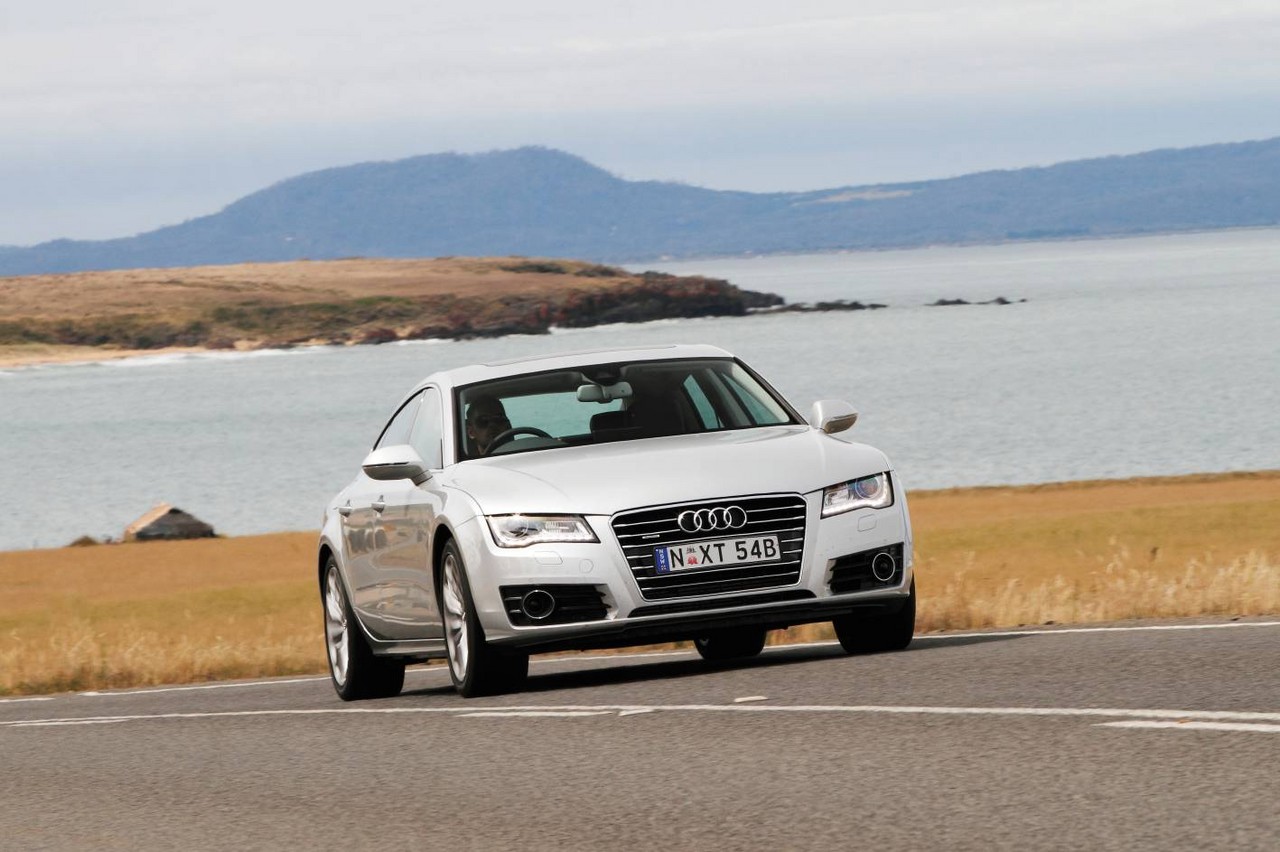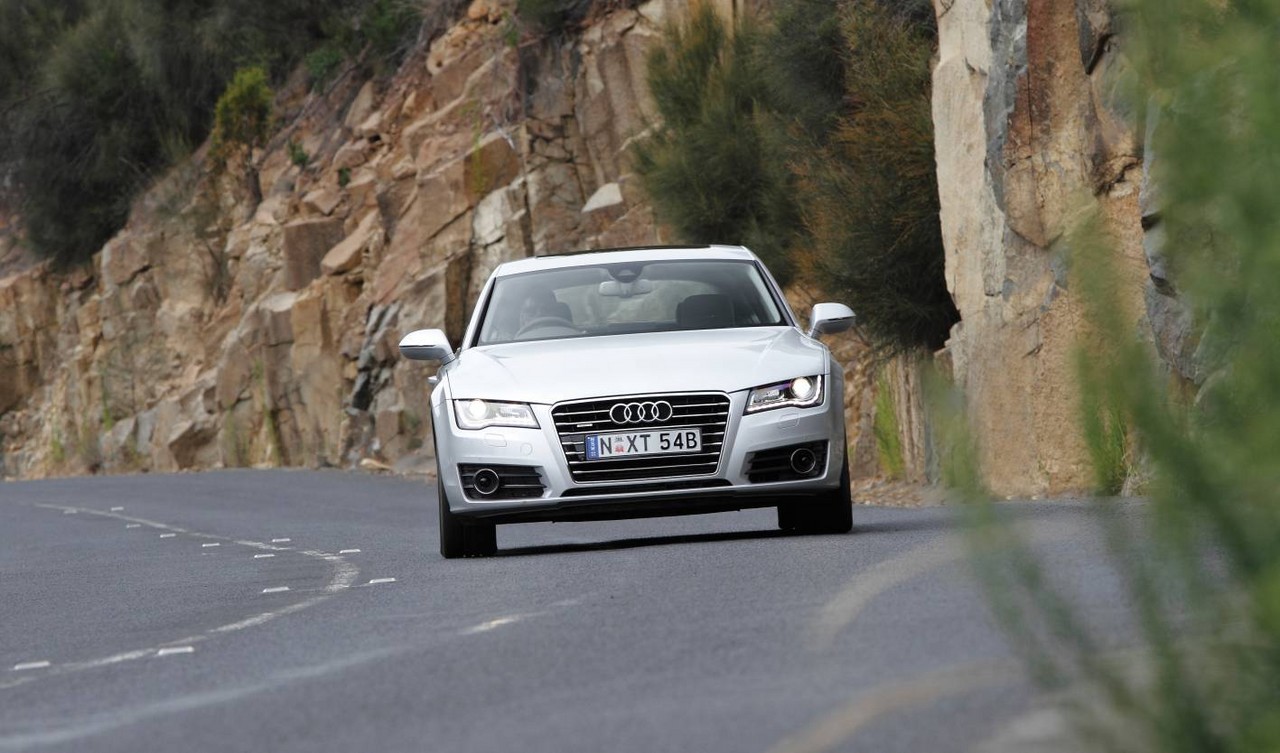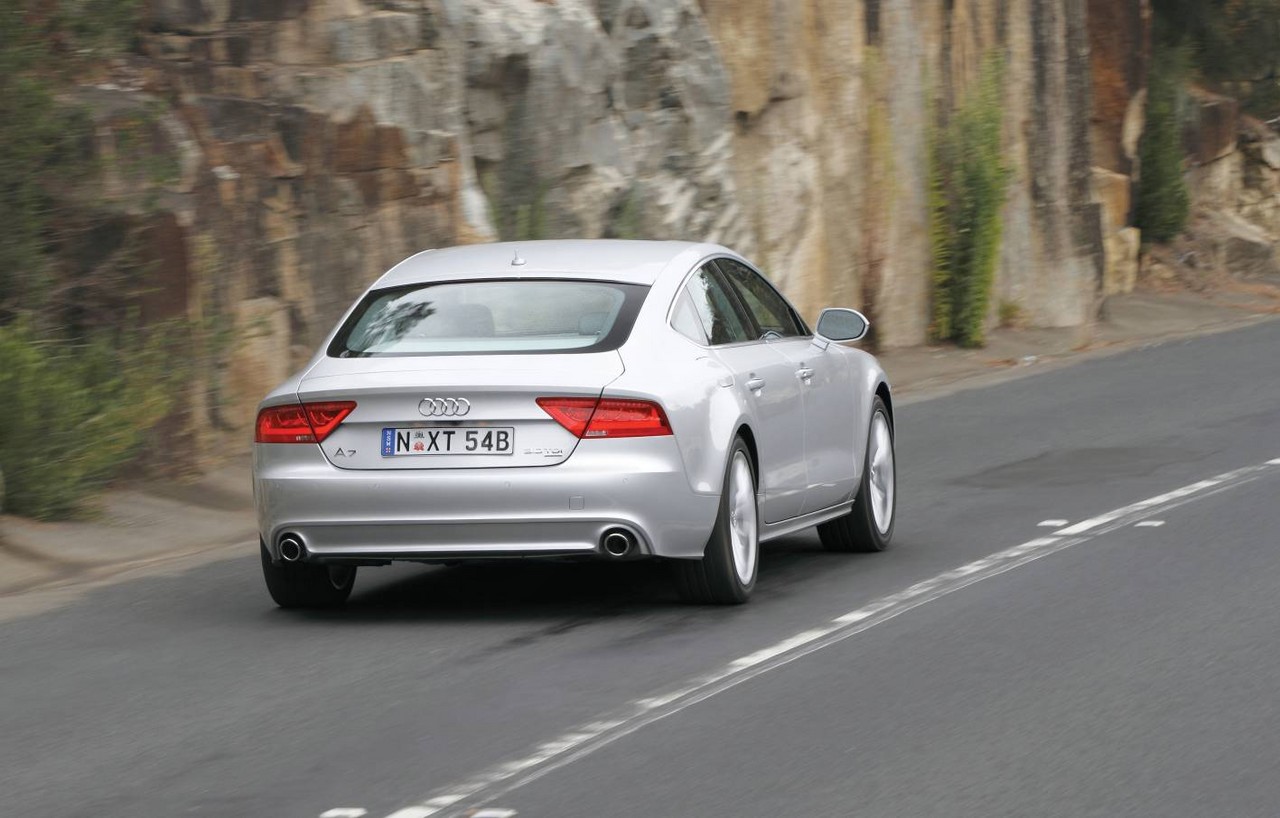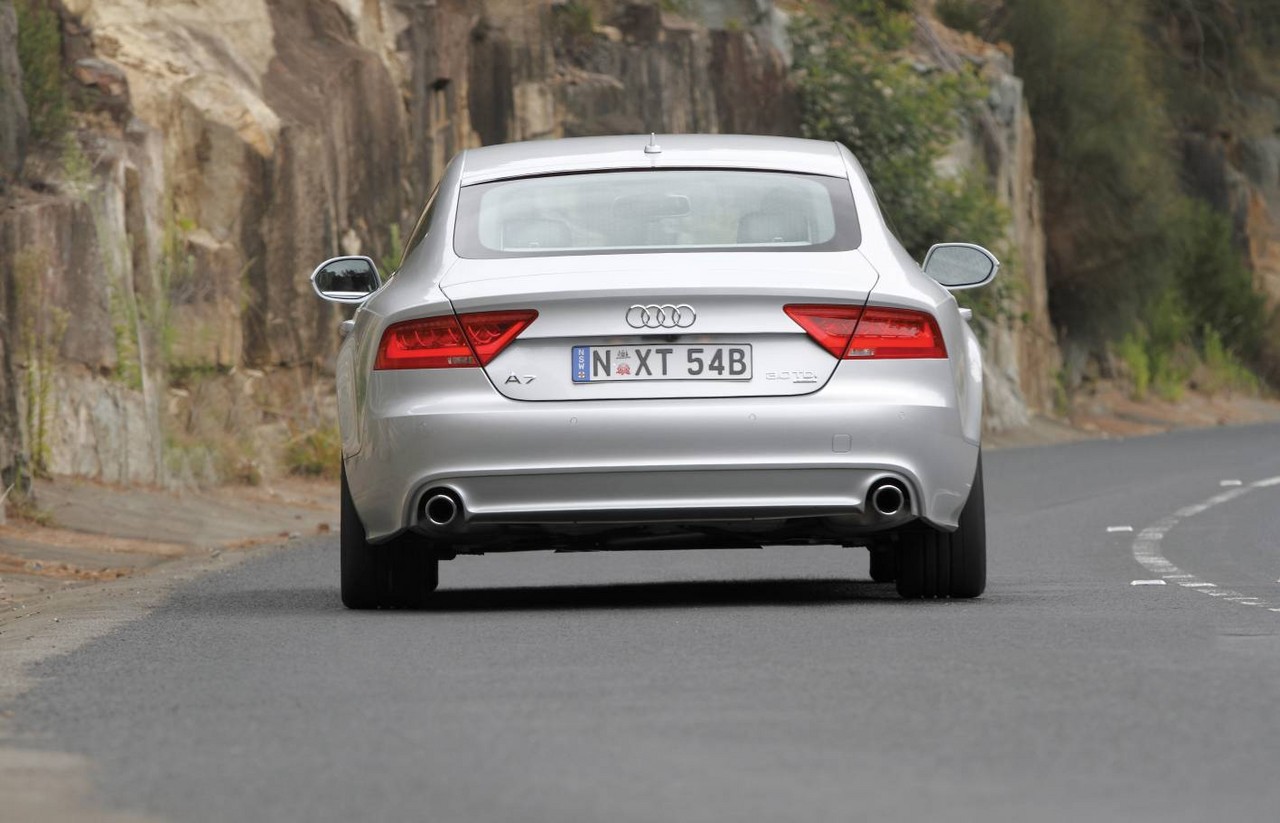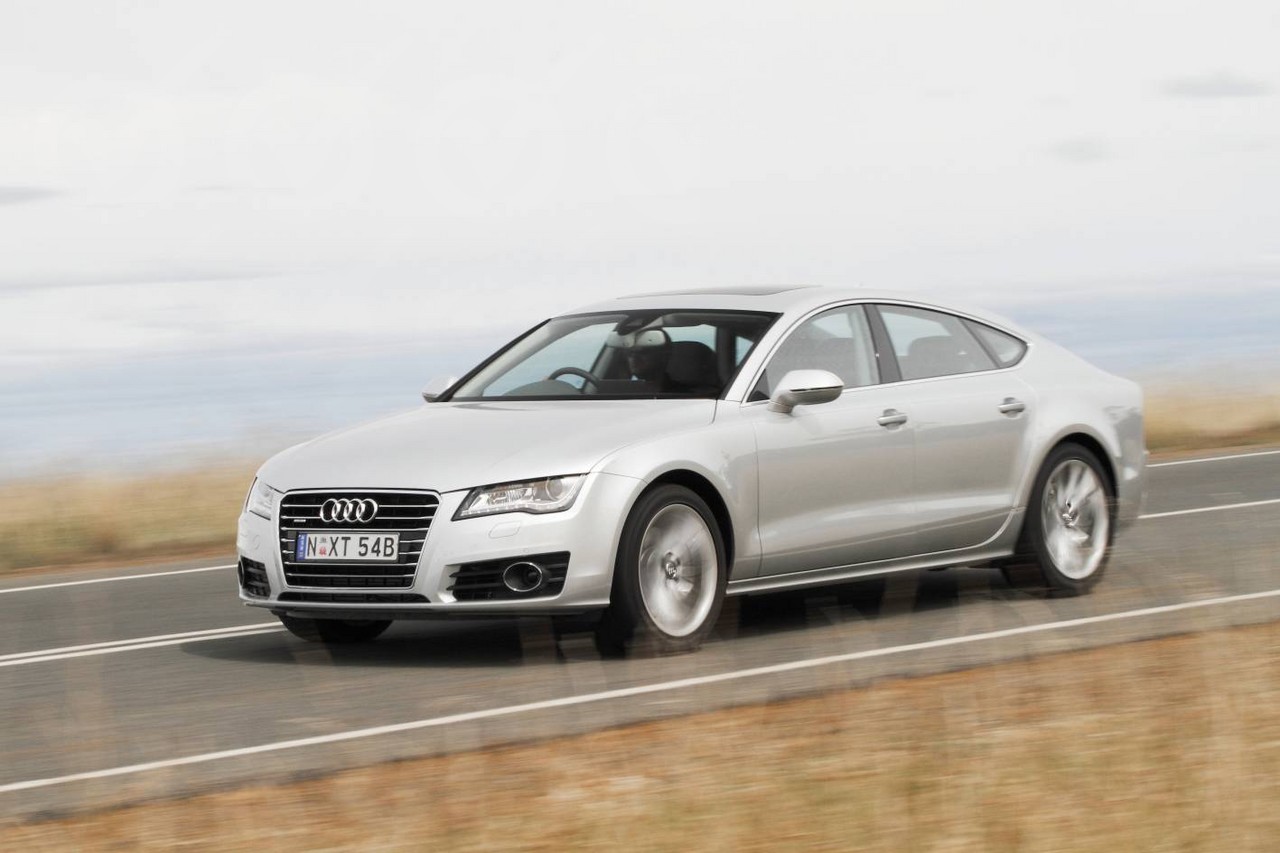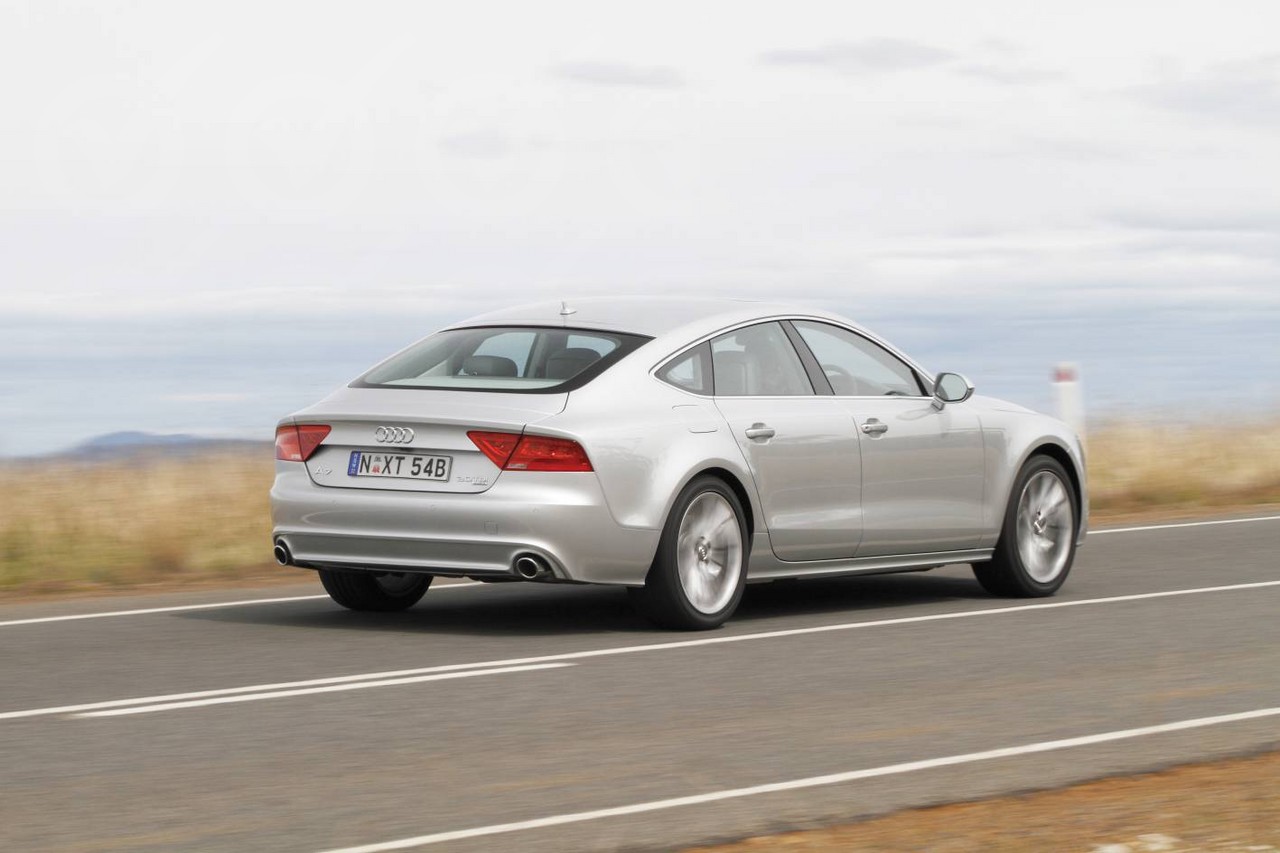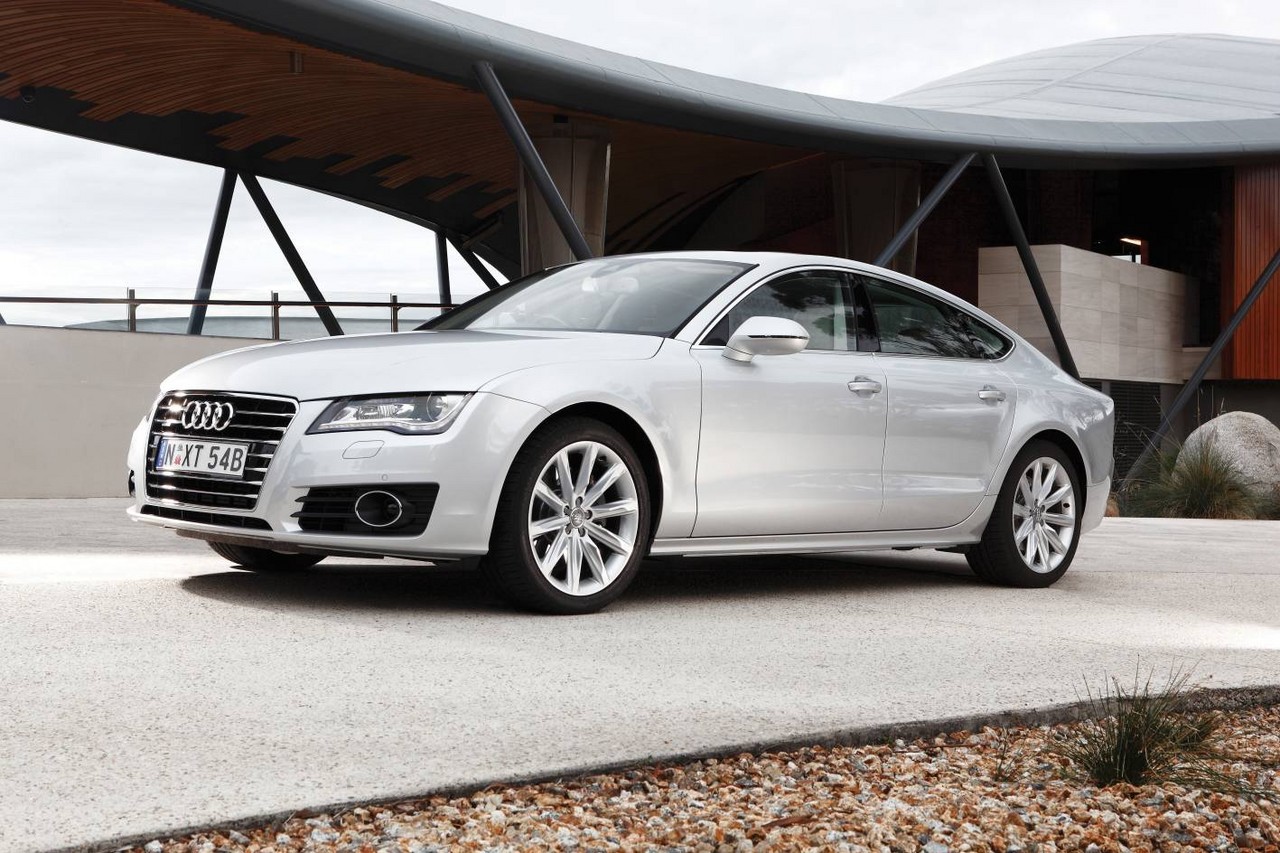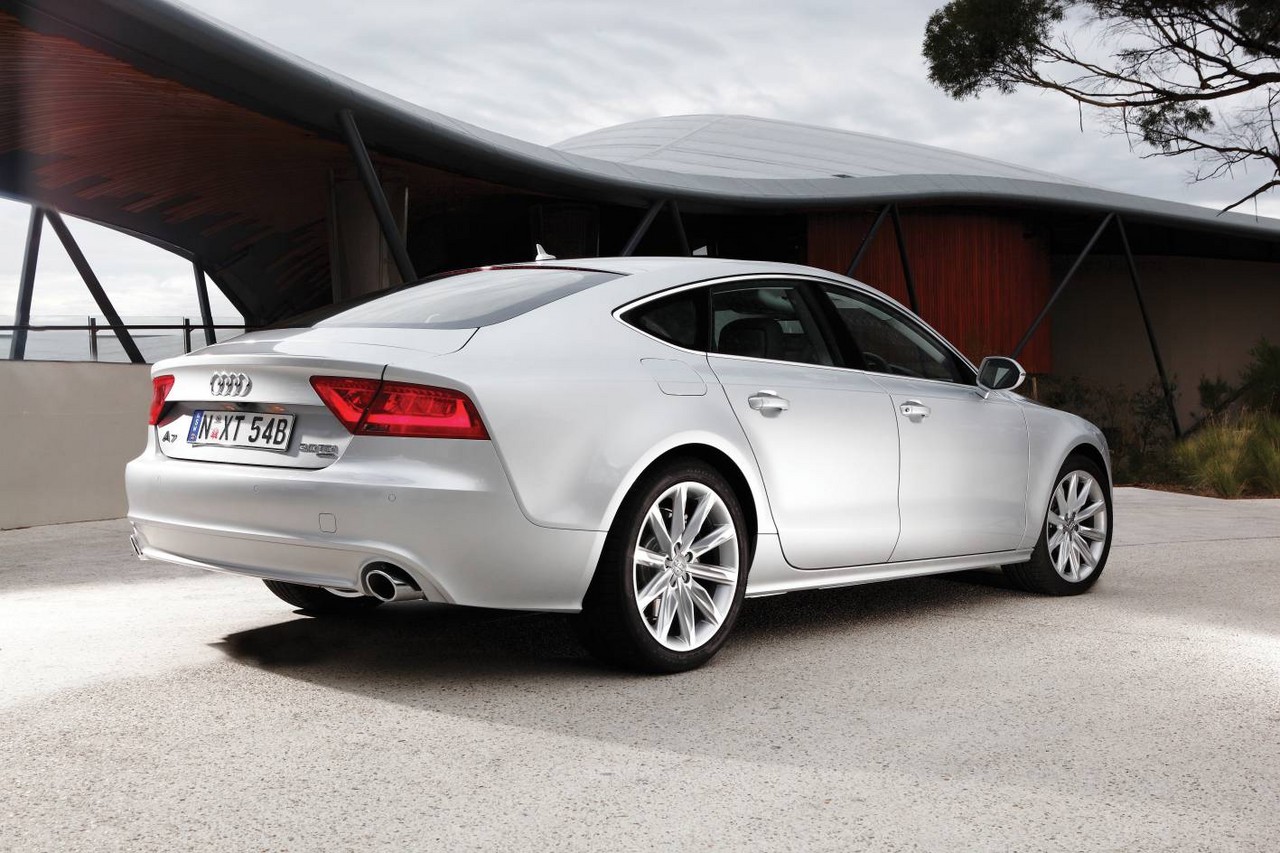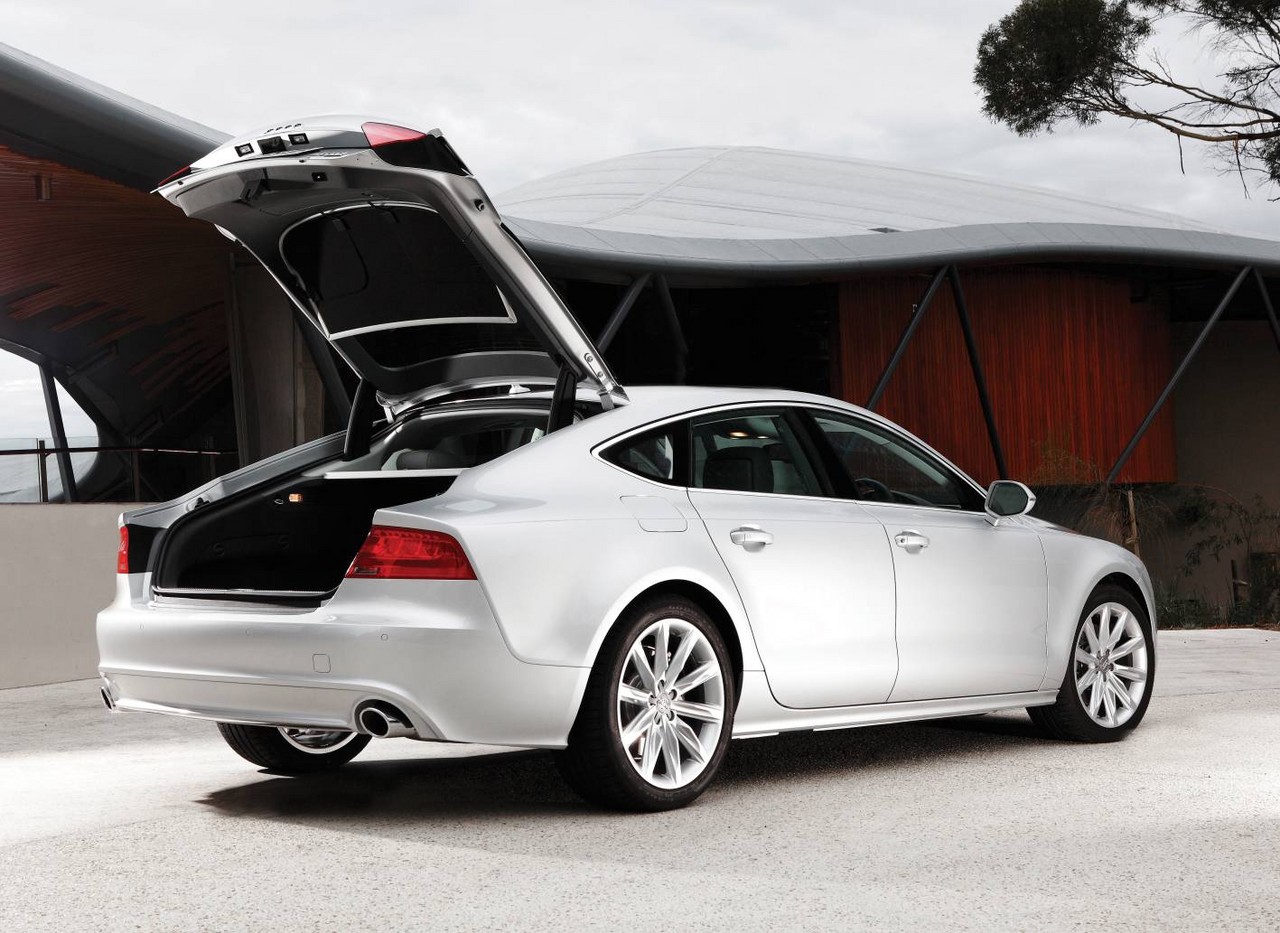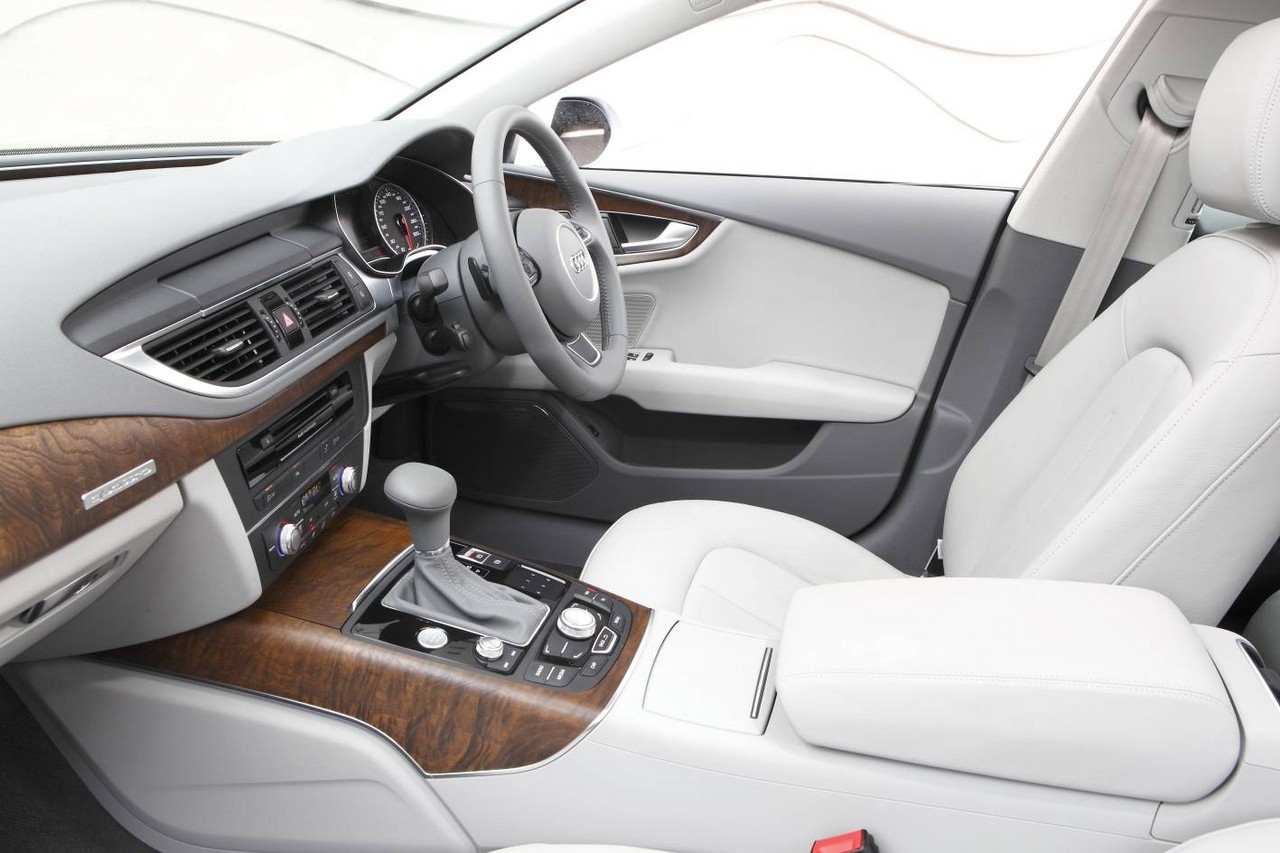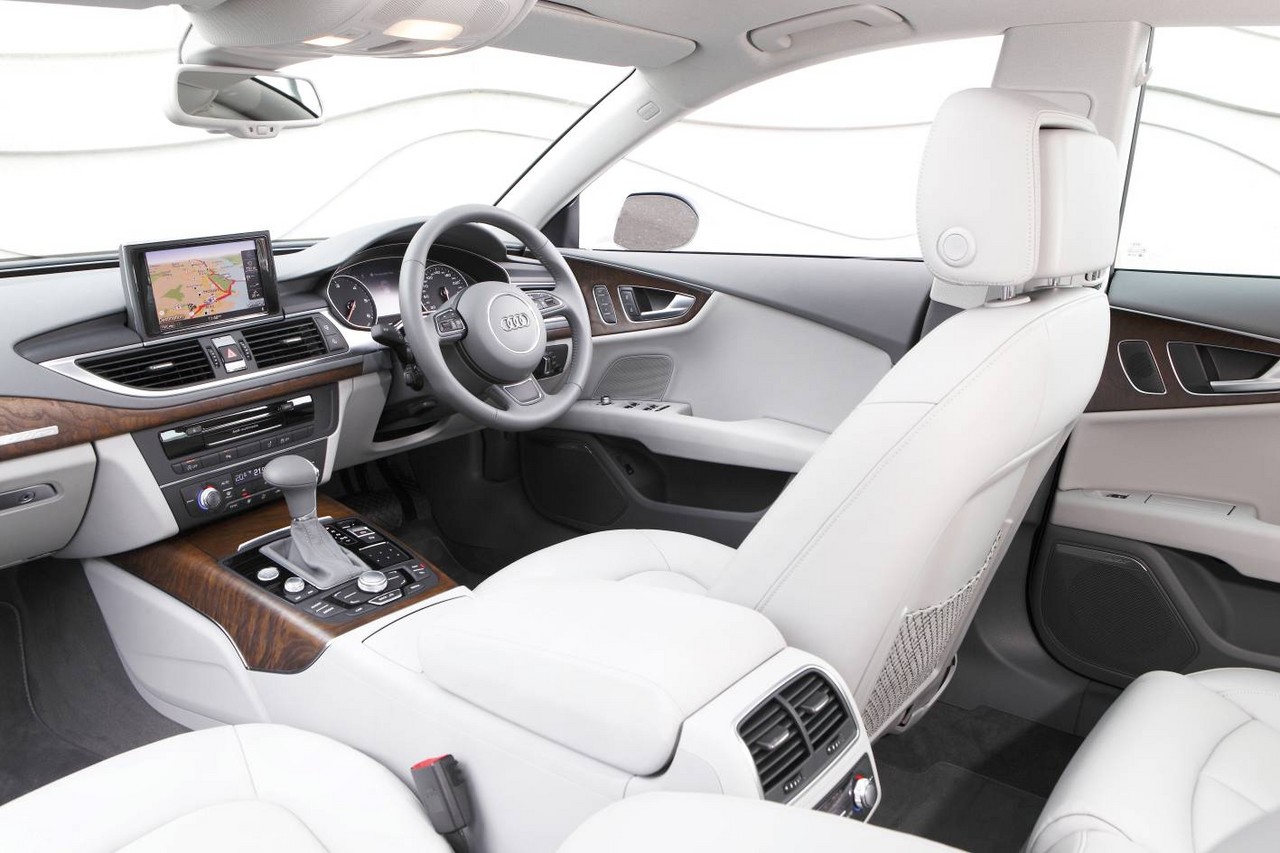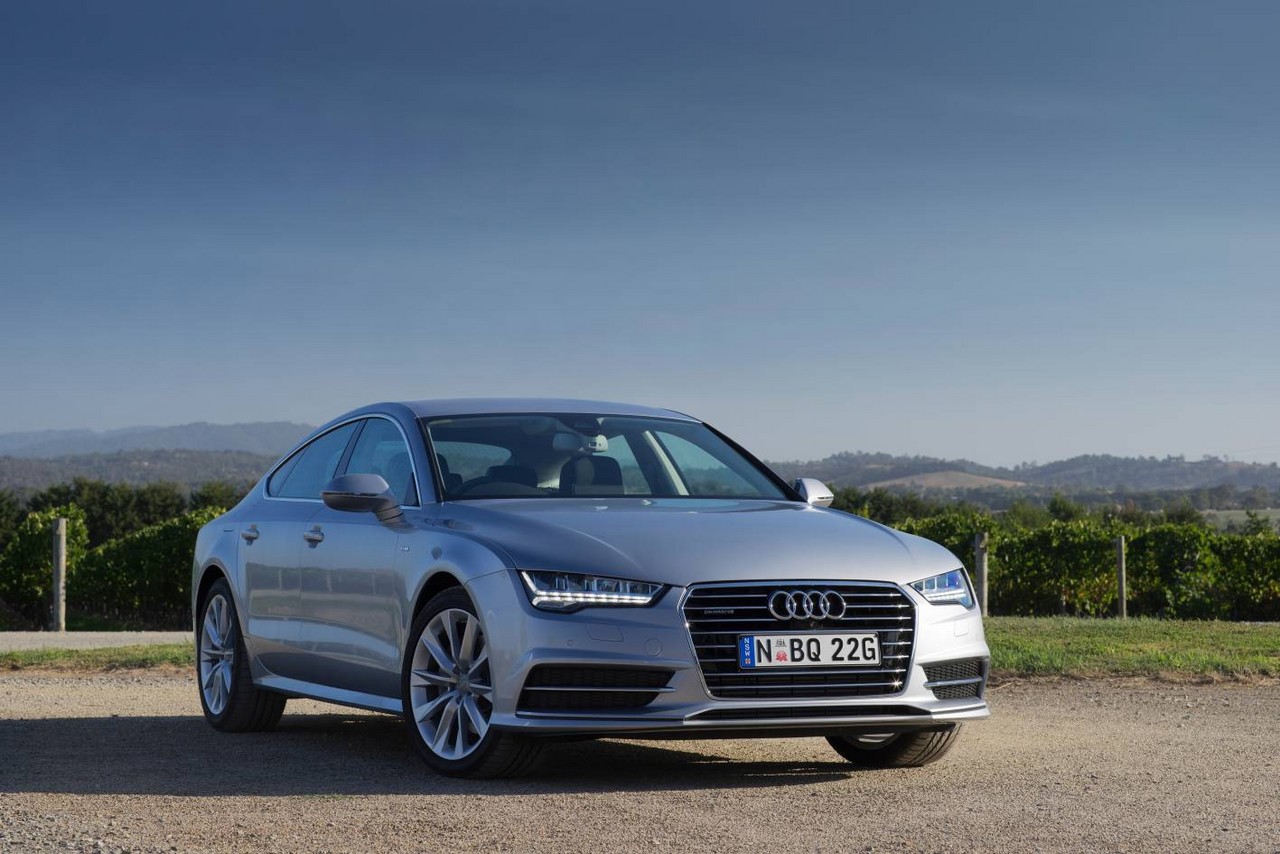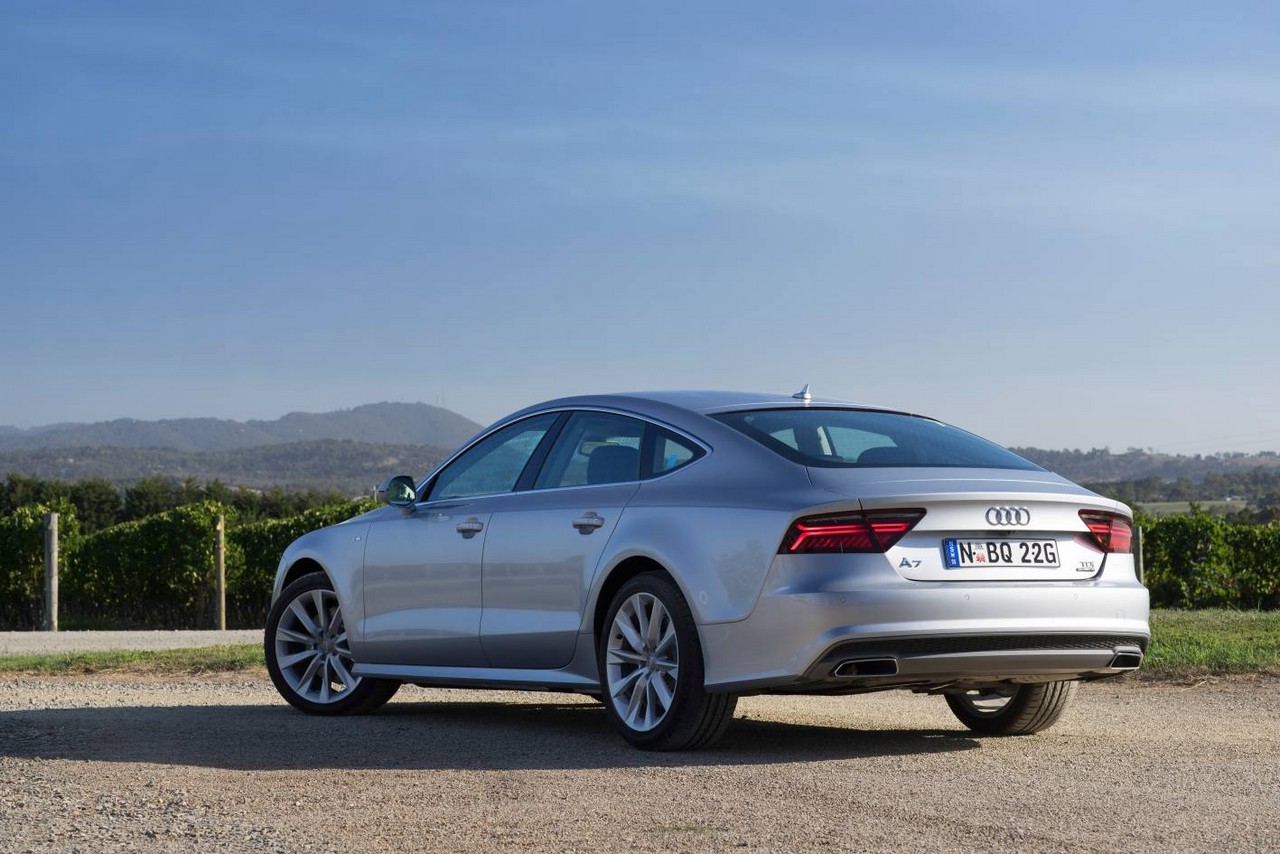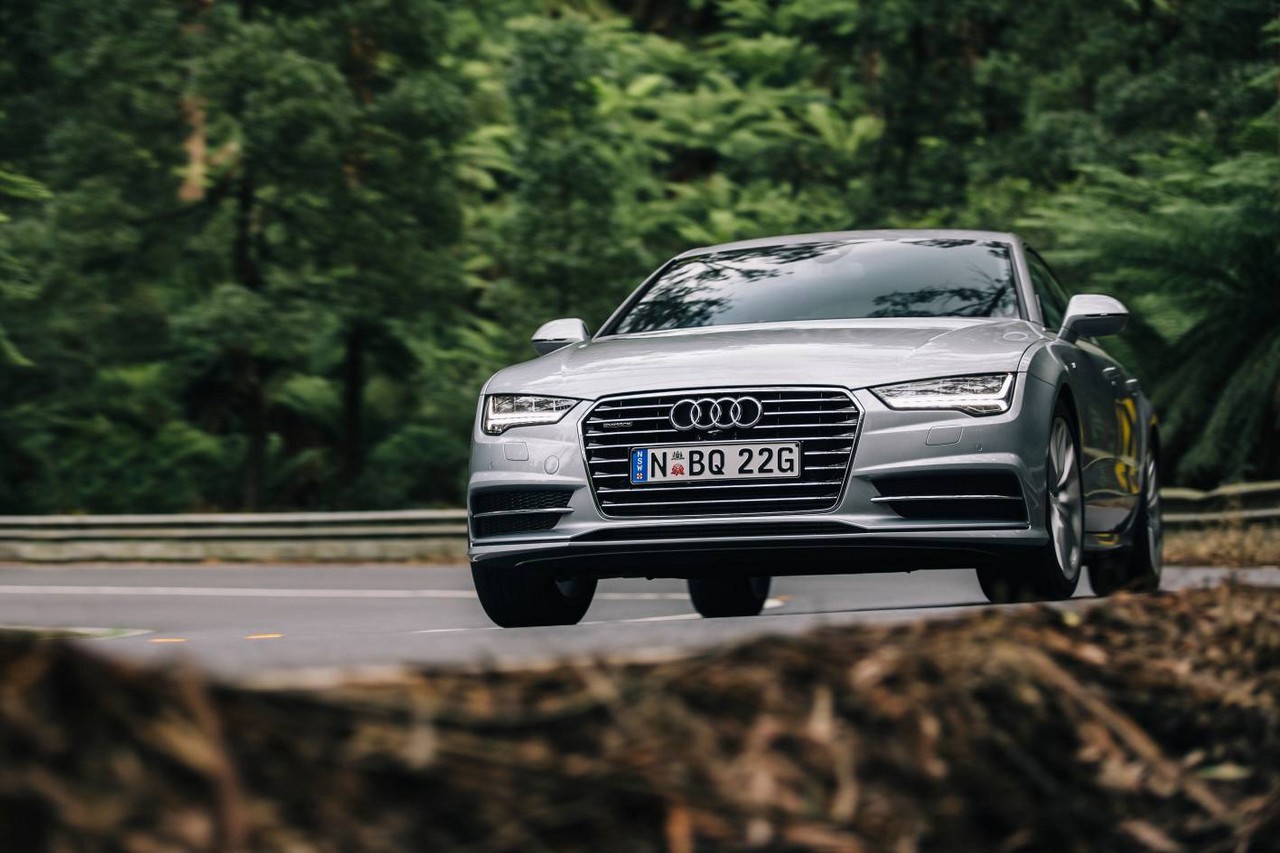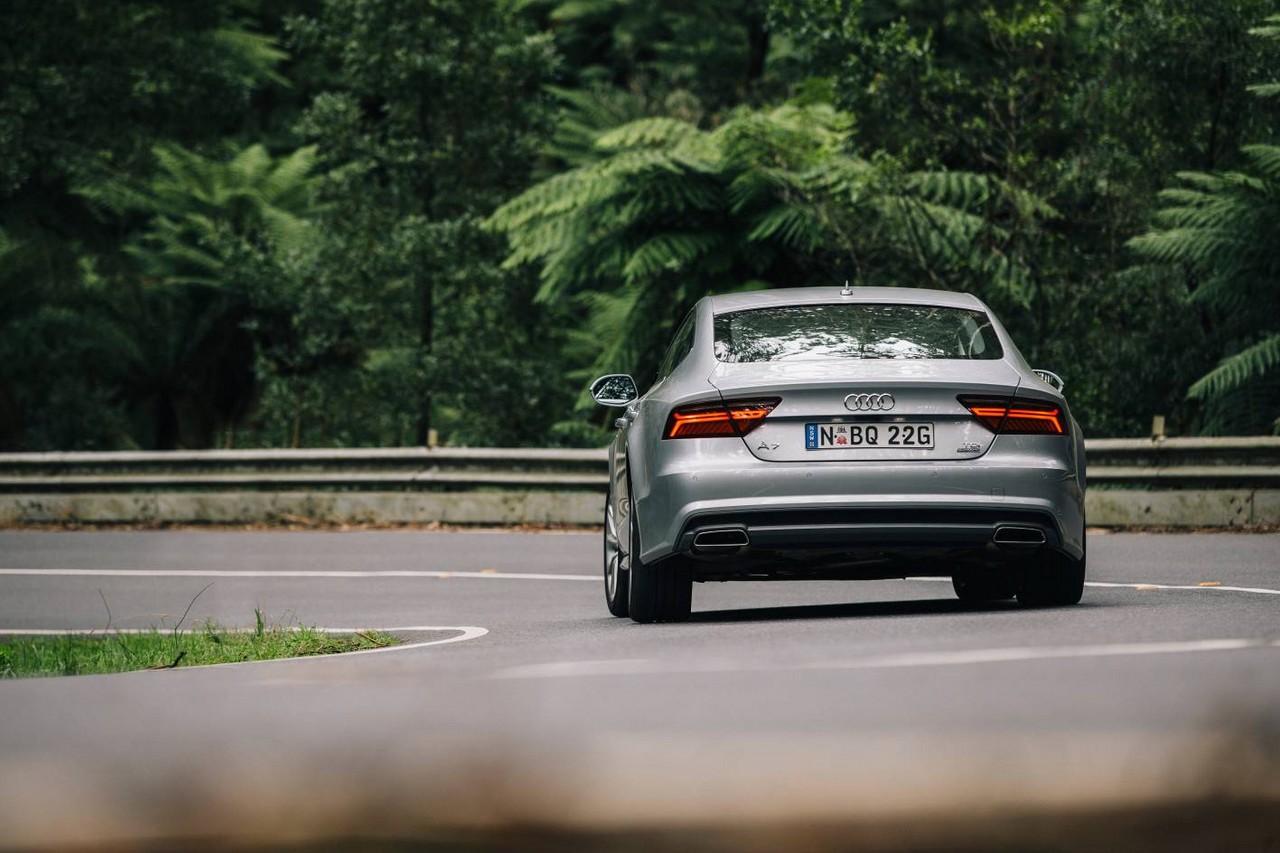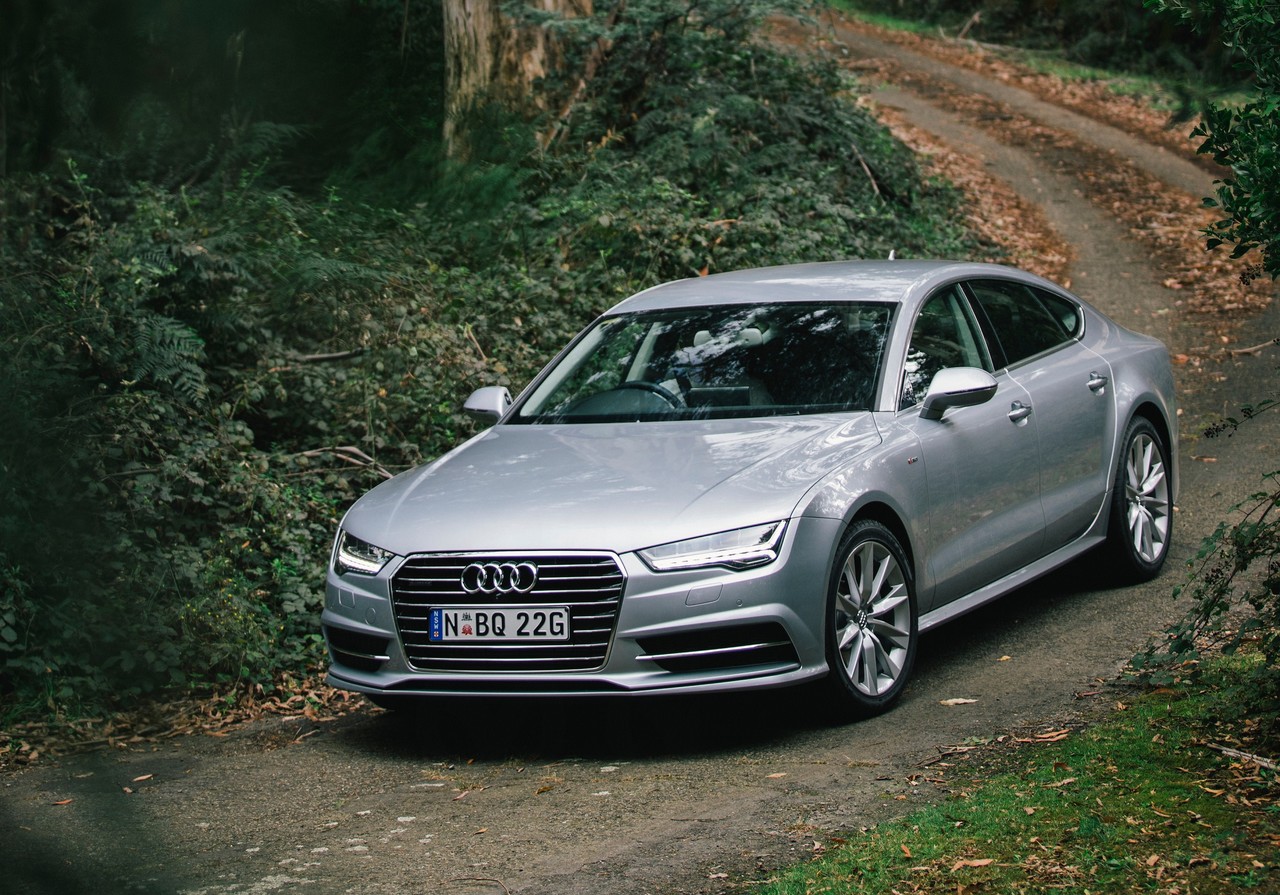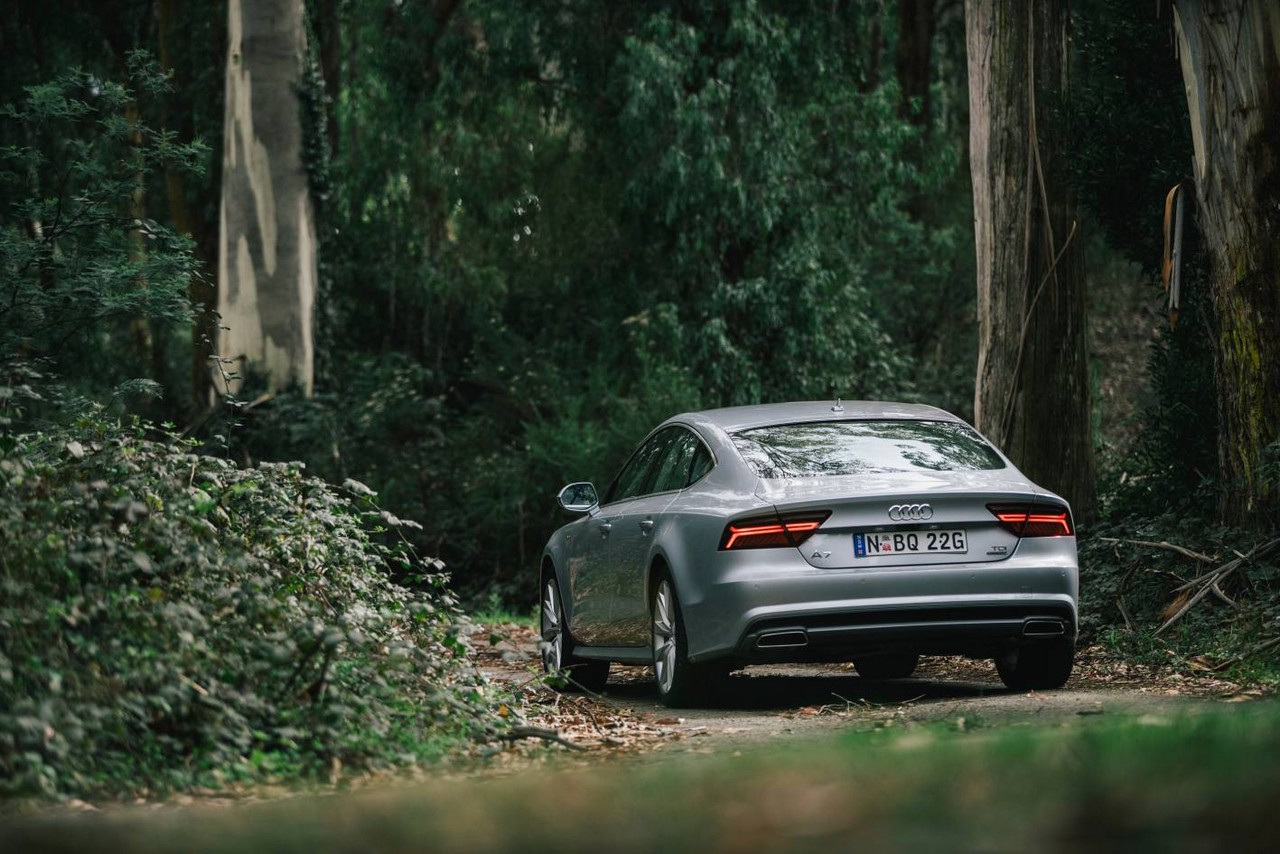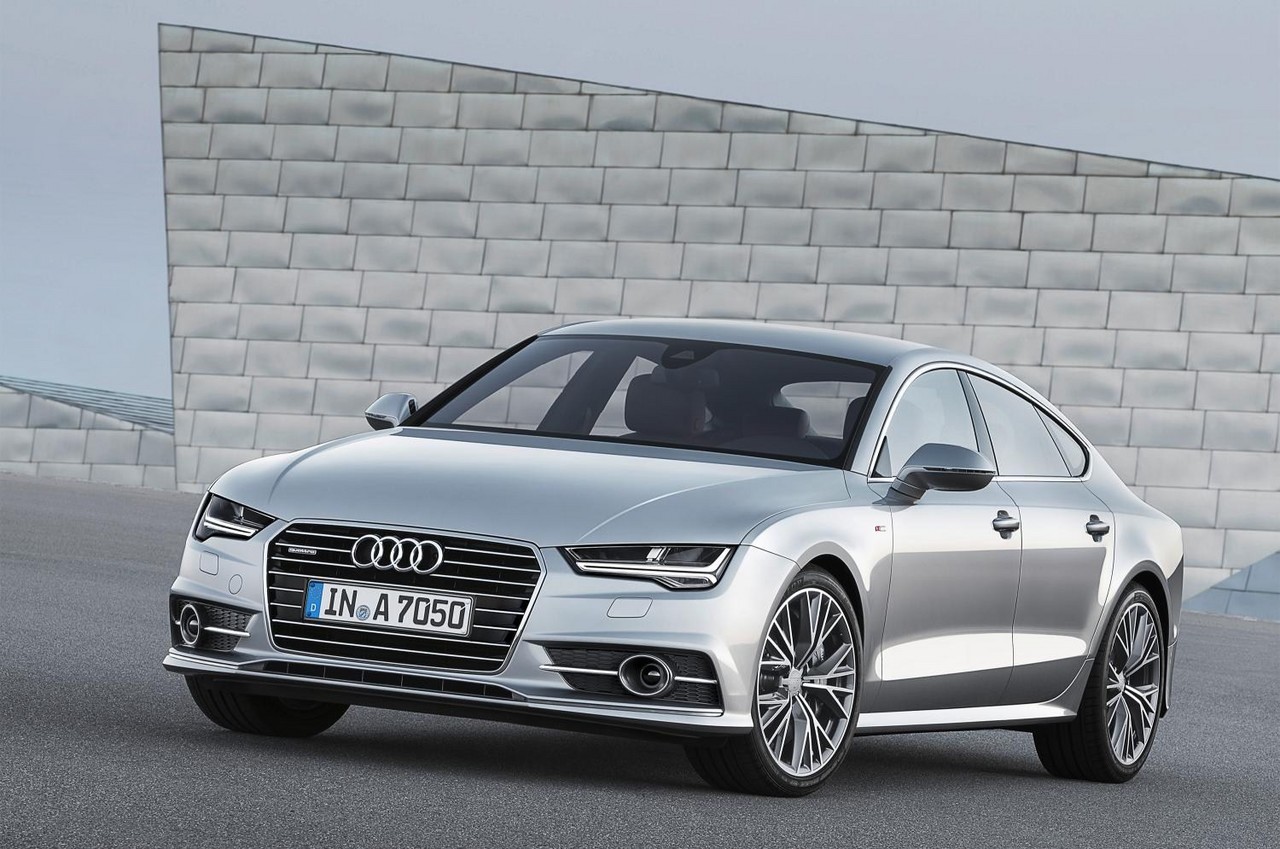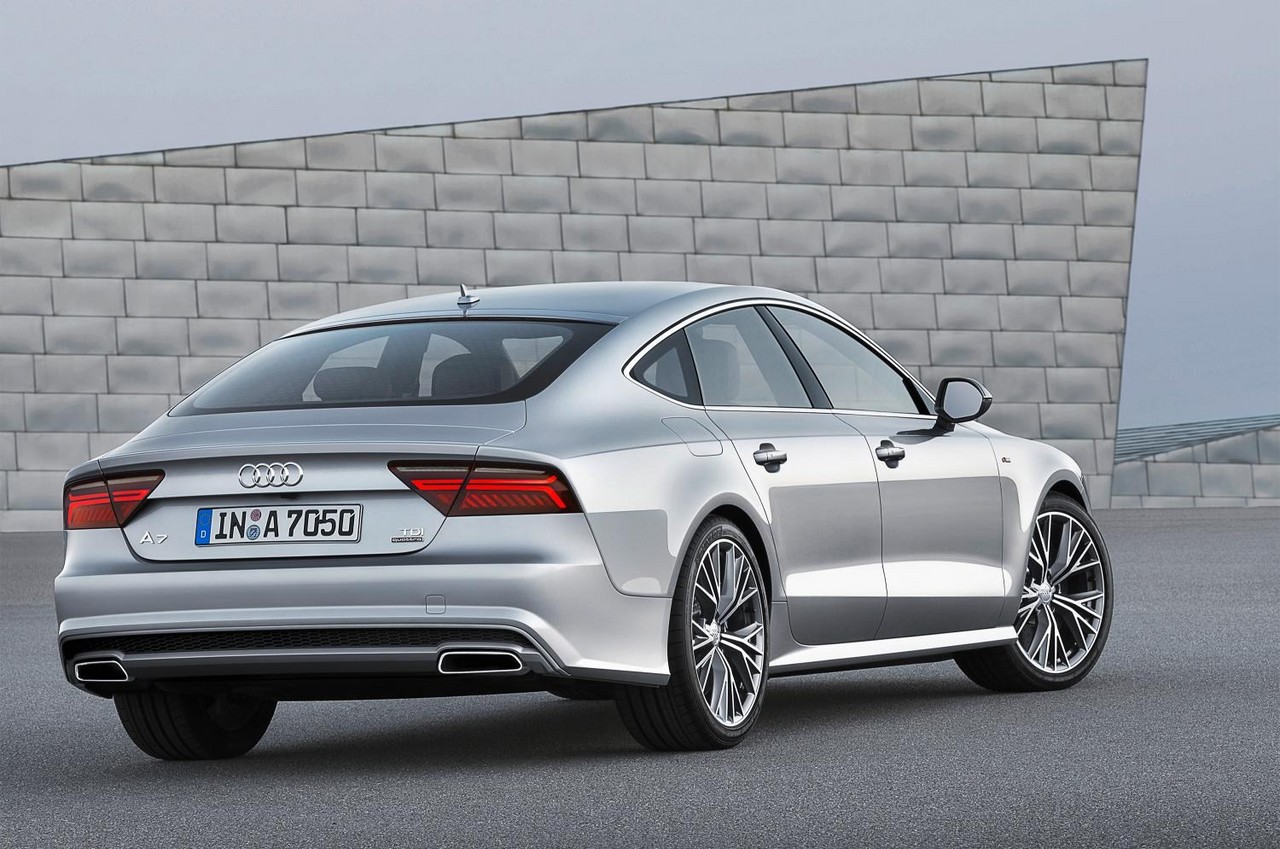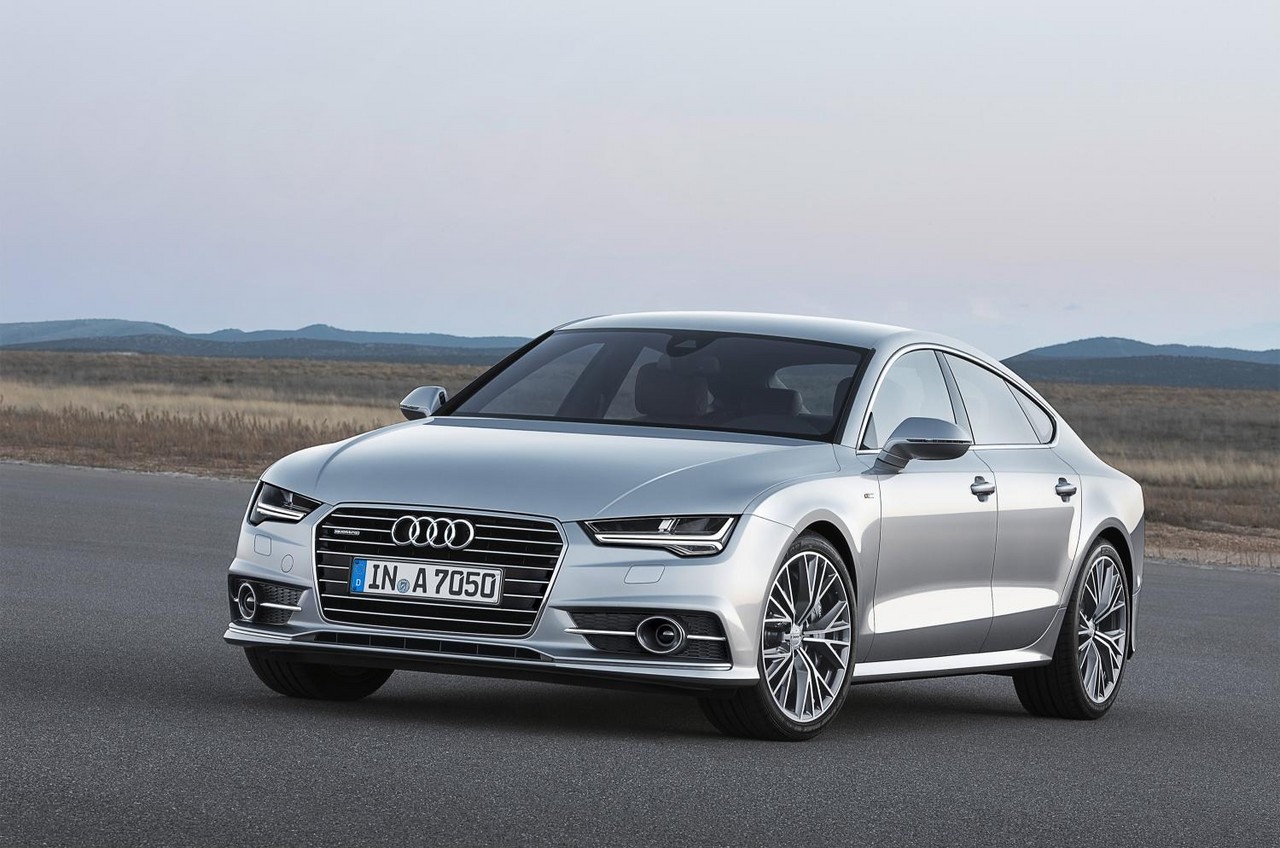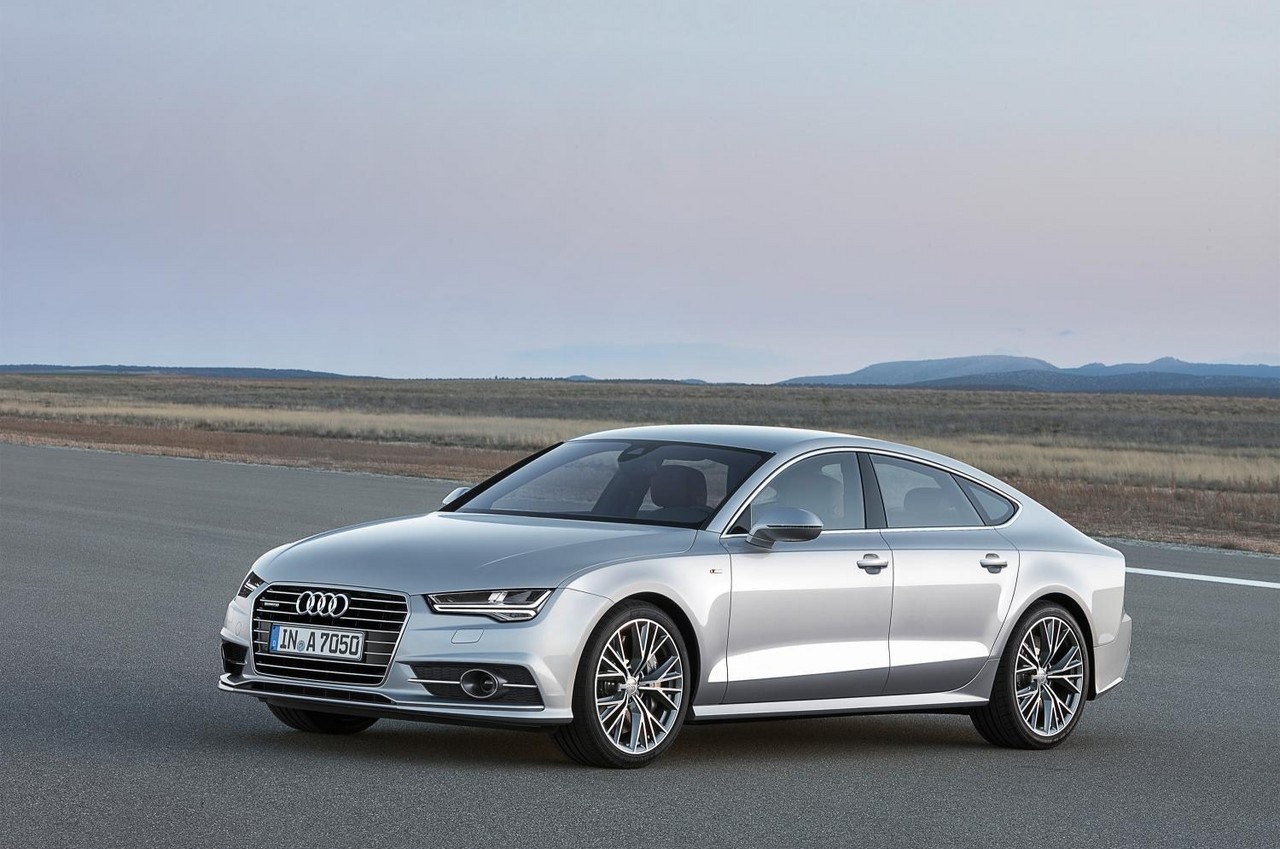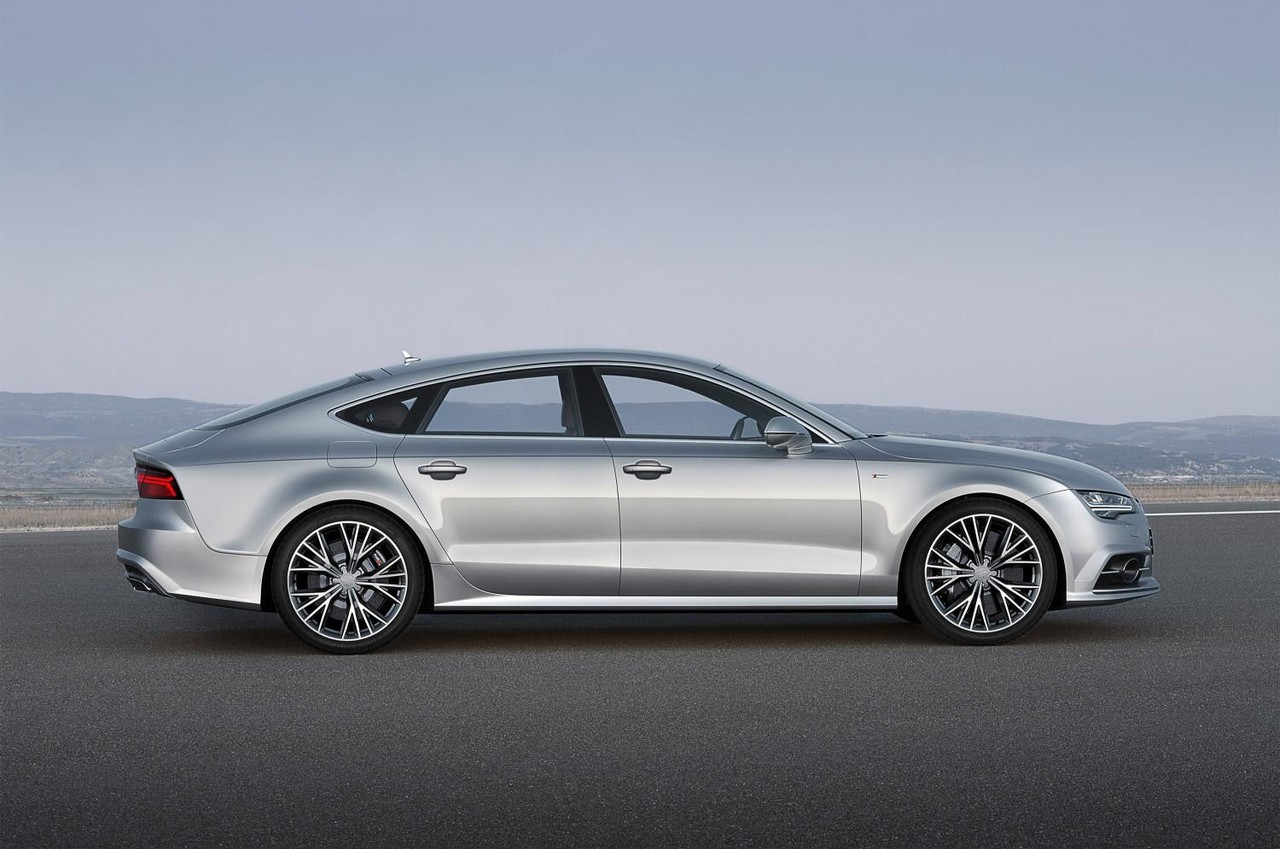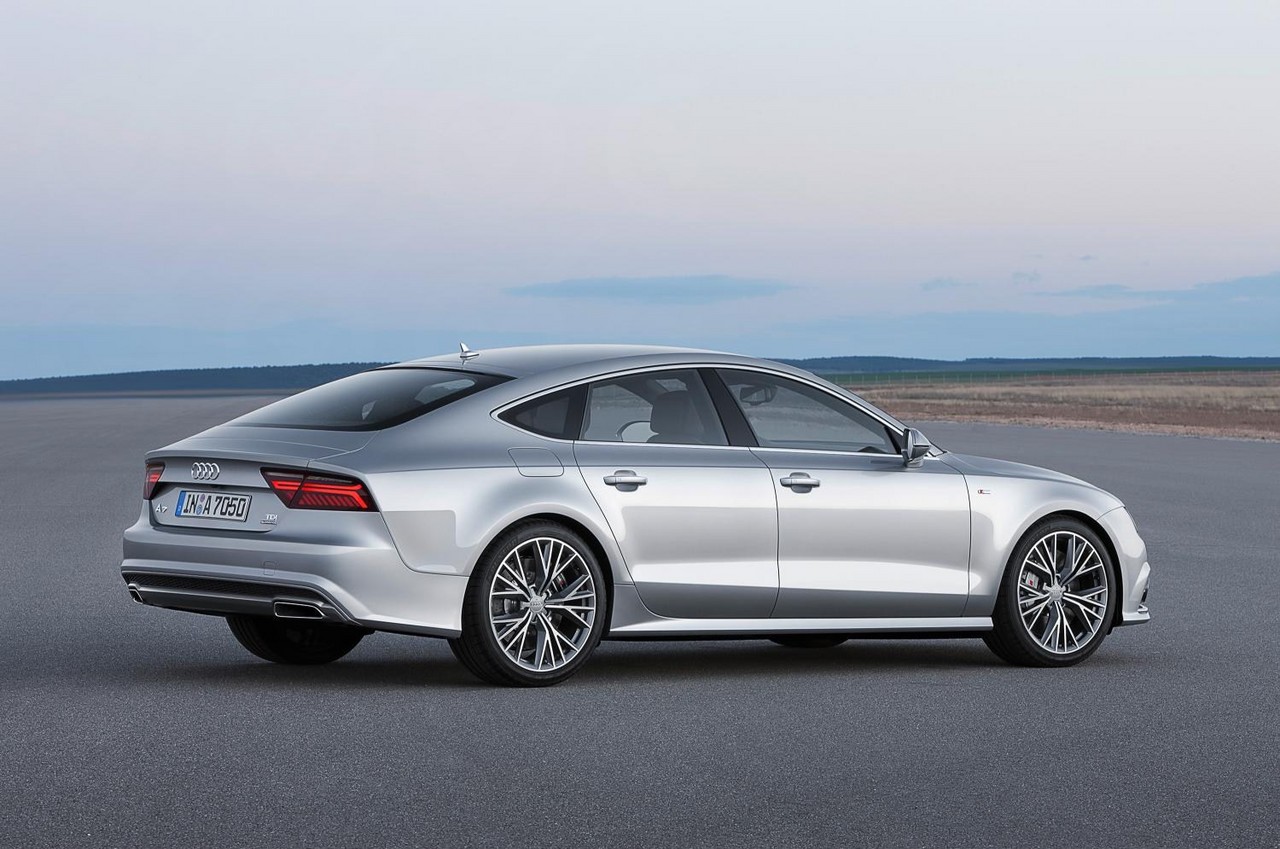
- Turbo-diesel engines bring grunt
- Impressive dynamics
- Optional Air suspension provides comfortable ride
- Liftback practicality and, generally, spacious interior…
- … but limited rear seat headroom
- Steering lacks feel
- Poor rear visibility
- Price premium to related Audi C7 A6
Review: Audi C7.I A7 Sportback (2011-14)
Overview
Released in March 2011, the Audi C7 Series I (C7.I) A7 Sportback was initially available as a five-door, four-seat liftback. Manufactured in Neckarsulm, Germany, the four-wheel drive A7 Sportback was initially available with either a 3.0-litre turbo-diesel V6 engine (the ‘3.0 TDI’) or a 3.0-litre supercharged petrol V6 (‘3.0 TFSI’). In February 2013, however, the 3.0 BiTDi was released.
Engines
Of the engines,
- the 3.0-litre supercharged petrol V6, direct injection, double overhead camshafts per cylinder bank, variable valve timing for the intake and exhaust camshafts, four valves per cylinder, an Eaton ‘Twin Vortices Series’ (TVS) Roots-type positive displacement supercharger with twin four-lobe rotors and two integrated water-cooled air coolers;
- the 3.0-litre V6 turbo-diesel engine had common-rail diesel direct injection, double overhead camshafts per cylinder bank, four valves per cylinder, a variable geometry Borg Warner turbocharger, two parallel side-mounted intercoolers and a diesel particulate filter; and,
- the 3.0-litre V6 bi-turbo diesel engine was distinguished by its two variable geometry turbines – positioned in series – with the smaller turbine providing boost pressure at low revs and the larger turbine operating from 2500 rpm.
All engines featured ‘idle stop’ (which enabled the engine to shut down when the vehicle was stationary) and regenerative braking (which utilised the vehicle’s kinetic energy when braking or coasting to charge the battery) to minimise fuel consumption.
2013 updates
From January 2013, the A7 Sportback was fitted with five seats as standard, while an eight-speed automatic transmission replaced the DCT for the 3.0 TDI; power and torque outputs were also increased for the 3.0 TFSI and 3.0 TDI, respectively.
| Variant | Engine | Trans. | Years | Peak power | Peak torque |
|---|---|---|---|---|---|
| 3.0 TFSI quattro | 3.0-litre CGWB s/charged petrol V6 | 7sp DCT | 2011-12 | 220 kW at 5250-6500 rpm | 440 Nm at 2900-4500 rpm |
| 3.0-litre CGWD s/charged petrol V6 | 7sp DCT | 2013-14 | 228 kW at 5500-6500 rpm | 440 Nm at 2900-4500 rpm | |
| 3.0 TDI quattro | 3.0-litre CDUC turbo-diesel V6 | 7sp DCT | 2011-12 | 180 kW at 3800-4400 rpm | 500 Nm at 1400-3250 rpm |
| 3.0-litre CDUD turbo-diesel V6 | 8sp auto | 2013-14 | 180 kW at 4000-4500 rpm | 580 Nm at 1750-2500 rpm | |
| 3.0 TDi Biturbo quattro | 3.0-litre CGQB twin-turbo diesel V6 | 8sp auto | 2013-14 | 230 kW at 3900-4500 rpm | 650 Nm at 1450-2800 rpm |
Dimensions and suspension
Compared to the Audi C7 A6 sedan on which it was based, the A7 Sportback was 42 mm longer (at 4969 mm), 37 mm wider (1911 mm), 45 mm lower (1420 mm) and had a 7 mm shorter wheelbase (2914 mm). Furthermore, the A7 Sportback had five-link front suspension with double upper and lower wishbones and self-tracking trapezoidal link rear suspension.
quattro all-wheel drive
The A7 Sportback was fitted with Audi’s quattro four-wheel drive system which included an Audi-developed ‘Crown Gear’ centre differential. In normal conditions, the system provided a 40:60 front:rear torque split. If traction was lost, however, up to 85 per cent of the engine’s torque could be directed to the rear axle, and up to 70 per cent to the front axle. The system also included open front and rear differentials with electronic differential locks which could brake spinning wheels to enable cross-axle torque transfers. A ‘torque vectoring’ rear axle – which selectively distributed torque to the rear wheels to generate yaw and thereby correct over- or under-steer – was available as an option.
Safety equipment
Standard safety equipment for the Audi A7 Sportback included dual two-stage front airbags, front and rear side airbags, full-length curtain airbags (i.e. for front and rear occupants), ABS, electronic brake force distribution, brake assist, electronic stability control, traction control and front and outer rear seatbelts with pretensioners and load limiters.
Features: A7 Sportback 3.0 TDI, TFSI and TDI Biturbo
Standard features for the Audi A7 Sportback 3.0 TDI included 18-inch alloy wheels, Multi Media Interface (Audi’s ‘MMI’) with a fourteen speaker 600 watt Bose stereo, twelve channel DSP amplifier, auxiliary inputs (iPod/USB/MP3), 20GB hard drive for music, satellite navigation, reversing camera, Bluetooth connectivity and voice recognition, four-zone climate control air conditioning, Milano leather upholstery, power adjustable front seats, cruise control, steering wheel gearshift paddles, xenon headlights with LED running lights washers, LED daytime running lights, automatic headlights, rain-sensing wipers, power sunroof, 60/40 split and folding rear seats, remote central locking with proximity key, power windows and mirrors, heated and folding door mirrors, driver’s seat and mirror memory settings, a power-operated park brake, tyre pressure monitoring, a trip computer and an immobiliser.
The A7 Sportback 3.0 TFSI and 3.0 TDI Biturbo were differentiated by their 19-inch alloy wheels.
Related links
Review: Audi C7.II A7 Sportback (2015-17)
Overview
Released in Australia in March 2015, the Audi C7 Series II (C7.II) A7 Sportback introduced a simplified range that was powered by Euro 6 emissions compliant engines. Visually, the C7.II A7 Sportback could be identified by its hexagonal single frame grille, LED headlights, re-sculpted bumpers, new tail-lights and wider trapezoidal apertures for the tailpipes.
Inside, the Audi C7.II A7 Sportback had a high-resolution Driver Information System (DIS) positioned between the speedometer and tachometer which could display map-based navigation.
| Variant | Engine | Trans. | Peak power | Peak torque |
|---|---|---|---|---|
| 3.0 TDI quattro | 3.0-litre CRTE turbo-diesel V6 | 7sp DCT | 160 kW at 3250-4500 rpm | 500 Nm at 1250-300 rpm |
| 3.0 TDI Biturbo quattro | 3.0-litre CVU biturbo diesel V6 | 8sp auto | 235 kW at 3900-4600 rpm | 650 Nm at 1400-2800 rpm |
Safety equipment
For the Audi C7.II A7 Sportback, standard safety equipment was extended to include:
- Audi side assist: used two radar sensors to monitor the area 70 metres behind the vehicle during lane change manoeuvres at speeds over 30 km/h. If there was a vehicle in the driver’s blind spot or an approaching vehicle was detected, the driver would be alerted by a warning LED in the respective door mirror. If the driver activated the turn signal, the LED would flash several times at high frequency;
- Audi pre sense rear: if a rear-end collision was anticipated, the seats would be moved into the safest position for a collision; and,
- Audi active lane assist: operating at speeds in excess of 65 km/h, a video camera could detect lane markings. If the vehicle approached a lane marking without indicating, the steering system would make automatic adjustments to keep the vehicle in its lane. The steering wheel could also be set to vibrate to warn the driver.
The A7 3.0 TDI Biturbo quattro was further equipped with:
- Adaptive cruise control (ACC): radar-based cruise control which maintained a preset distance from the car ahead. For the S7, ACC included a ‘stop & go’ function for low speeds which could bring the vehicle to a stop and accelerate from rest; and,
- Audi pre-sense front: in the event of a pending front-to-rear collision with the vehicle ahead, the driver would be progressively is warned and brakes could be applied autonomously (‘Autonomous Emergency Braking’). At speeds below 30 km/h, nearly full braking force would be applied;
Features
Standard features for the A7 Sportback 3.0 TDI quattro were extended to include 19-inch alloy wheels, Audi’s new MMI navigation plus system (with an eight-inch monitor, MMI touch, live traffic updates, CD/DVD player, auxiliary inputs (3.5 mm/USB/SDXC card readers) and 10GB flash memory) LED headlights and power folding door mirrors.
The A7 Sportback 3.0 TDI Biturbo quattro was further equipped with 20-inch alloy wheels.
As an option, the A7 Sportback was available with ‘Matrix LED’ headlights which could dim individual diodes to divert their pool of light around oncoming and following traffic without reducing their intensity in other areas.
Related links
- Specifications: Audi C7.II A7 Sportback (March 2015)
- Technical Data: Audi C7.II A7 Sportback 3.0 TDI (March 2015)
- Technical Data: Audi C7.II A7 Sportback 3.0 TDI Biturbo (March 2015)
- Press Kit: Audi C7.II A7 Sportback and S7 Sportback (March 2015)
- Audi Australia: Audi A7 Sportback
- Wikipedia.org: Audi A7 Sportback
